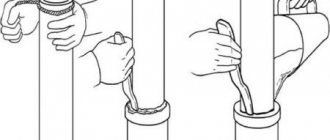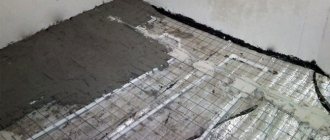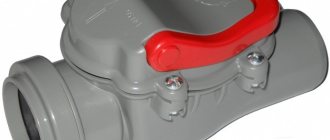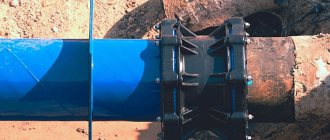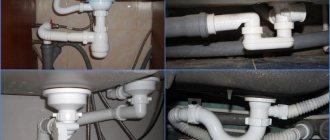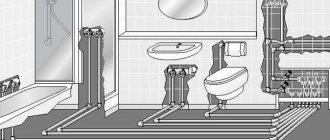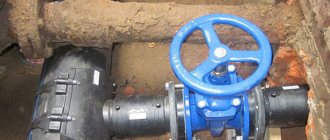Not all users know how to caulk a cast iron sewer pipe. Moreover, not everyone understands what we are talking about. However, during the assembly or reconstruction of a sewer system, the ability to correctly caulk pipe joints will be very useful.
Many houses still have old cast iron pipelines, which are not practical to completely replace with modern plastic. The pipes are still strong, capable of working for decades. As a rule, they are left intact, replacing only the apartment horizontal sections of wiring. Let's look at how cast iron pipes are connected when installing drainage systems.
Features of cast iron pipes
Cast iron pipes were used everywhere in Soviet times. Alternative fabrication materials have been used on a limited scale for the assembly of specialty sewer lines. The properties of cast iron pipelines allow the old system to still work. The advantages of these pipelines:
- strength;
- long service life;
- resistance to temperature changes;
- ability to work with aggressive liquids.
The disadvantages are:
- susceptibility to corrosion;
- heavy weight;
- fragility, inability to withstand sharp blows;
- difficulty of assembly.
The most significant drawback is the complex connection procedure, or chasing, of cast iron sewer pipes. Combined with the large weight of the parts, which create a significant load on the supporting structures, such drainage lines were difficult to install and maintain. However, the durability and reliability of cast iron systems are appreciated by experts. All networks, the condition of which does not cause concern, are still effectively used for wastewater disposal.
Chasing and embossing of cast iron pipes
Since chasing cast iron pipes is a very labor-intensive job, as any specialist will tell you, it is wiser to carry out preventive inspections than to wait until a large-scale repair of the sewer system is required. Since for external sewer networks cast iron is still mainly used as the main material for pipes, which cannot yet be completely replaced with modern plastic analogues, one should pay special attention to prevention. In our article we will talk about two types of pre-repair and post-repair work - caulking and caulking of cast iron pipes.
Cast iron joint made by caulking
Connection methods
The assembly of cast iron pipelines is a complex and responsible task. There are several types of connections:
- into the bell This is the most popular type, which is called “caulking of sewer pipes.” The process requires accuracy and experience, strict adherence to technology requirements. Proper caulking can withstand several decades of leakage use;
- coupling connection. This option is used for socketless pipes. Special couplings are used that tightly grip the edges of the elements being connected. The build quality is high; no special experience or skills are required to complete the work. However, the necessary conditions for installing the coupling are not always available.
There are couplings that are not equipped with threaded clamps. They consist of two sockets into which the ends of the elements to be connected are inserted. Assembly of such lines also requires stamping of sewer pipes, performed using standard technology.
The procedure consists of filling the socket gap with a sealant and sealing it using hardening compounds. The sealant most often used is tarred hemp strand, which is stuffed into 2/3 of the socket and thoroughly compacted. The remaining third is then filled with a durable protective compound. For this purpose, cement and plumbing sulfur are used. Lead caulking is sometimes used in pressure lines, a complex but very effective procedure.
Types of connection
There are several docking methods. Thanks to a wide range of options, it becomes possible to select the most suitable method, taking into account the operating conditions of the pipeline. Overview of connection types:
- Trumpet. Communications in this case have an expansion on one side. It resembles a cuff. A rubber gasket is installed in the socket. Then a pipe is inserted into this expansion. The result is a reliable, durable connection. However, its quality is determined by the characteristics of the gasket. If the rubber becomes deformed or loses its properties, which often happens during long-term use, a leak will form. It can be eliminated by replacing the gasket.
- Sealing method. In this case, communications with a socket are used, but the gasket is not installed at the joint. The cracks are filled with tow and then cemented.
- Socketless connection. In this case, an adapter in the form of a coupling is used. Communications are installed into this product on both sides. Then, in this section, the pipeline elements are tightened using metal clamps.
- Plastic docking. Docking according to this principle is performed when it is necessary to connect sections of cast iron and plastic pipelines. For this purpose, special adapters and sealant are used.
How to hammer a bell
During repair work, reconstruction or expansion of the drainage system, it often becomes necessary to connect different lines. Before caulking a sewer pipe, it is often necessary to disassemble an old, defective connection. It is extremely difficult to hammer out a bell that has become overgrown with monolithic layers over many years. The main problem is the danger of destroying the socket of an entire pipe or tee. If this happens, you will have to disassemble and replace the entire riser or horizontal pipeline.
Before caulking out an old cast-iron sewer, it is necessary to clean the connecting element and remove all foreign objects and deposits. As a rule, various temporary patches of paint, additional layers of mortar, and other materials are applied over the standard connection. All such areas must be completely removed.
After this, it is necessary to determine what material the insulating seal is made of, since it is much easier to caulk a cast iron sewer with cement than with sulfur. If cement mortar is used, the process of disassembling the joint will be easier. However, if pouring with plumbing sulfur was used, the procedure will be complicated. The material will have to be heated with a gas torch or blowtorch, since it will not be possible to simply break and remove particles from the gap - sulfur has high strength and viscosity. You will have to work in a gas mask, since toxic gases will be released when heated.
Procedure
In order to caulk a cast iron drain, you must first remove the cement or sulfur filling (1/3 of the depth of the socket), and then remove the hemp strand (2/3 of the depth). The first stage requires caution and accuracy. There is a high risk of breaking the socket of a tee or other receiving element. First they use a chisel, then a screwdriver with a long thin blade. With gentle blows of a hammer, the screwdriver is immersed in the gap, breaking off small pieces of the seal.
Many sources recommend first tapping the socket around the circumference with a hammer, and then checking to see if the pipeline has become loose. This is useless advice, since it is impossible to caulk cast iron sewers in this way. Until the top layer of cement or sulfur is removed, the pipe will not be able to swing. In addition, hammer blows can break the socket, which will significantly increase the amount of work.
When the hard plug is removed, the joint will gain mobility. They move it a little to the side, pick up the rope and pull it out, swinging the pipe to the sides to facilitate the process. After this, the bell will be completely freed, the connecting element can be easily removed.
Also read: What is the danger of sewer smell to health: the composition of the gas, where it comes from
Caulking a cast iron pipe
Properly executed caulking
When replacing a sewer riser, a deck chair from a common riser, a toilet, etc. many have encountered the problem of caulking a cast iron pipe. It turned out that the procedure is not as simple as it seems.
Let's take a closer look at the process of caulking a cast iron pipe:
- To begin, carefully tap the socket with a hammer, making sure not to break the sewer socket entering the riser or going out to the neighbors, which will require an expensive replacement of the entire riser.
Pipe branch - If the bell wobbles and gives way, it means that the caulking of the pipes was done in the old way using a rope and a cambola:
- At the same time, they begin to loosen the bell in different directions;
- Pry up the rope with a screwdriver;
- Grab the rope with pliers;
- They slowly pull out the rope, loosening the bell.
- If the bell sits firmly, this indicates that it is most likely filled with sulfur and knocking on it is useless. In this case, using a torch or blowtorch, start in a circle. You should also be careful not to damage the bell.
Important: when burning sulfur, you should definitely wear a respirator, since this procedure causes significant harm to health, including death.
- When burning out the sulfur, you should continue to tap with a hammer until the bell begins to move.
- Next, using an adjustable wrench, loosen the bell left and right, sometimes pulling it towards you.
- After removing the bell, use a chisel, pry bar or chisel to clean its seat in order to insert the sealing rubber smoothly and without distortions.
- Cover the rubber band with silicone and insert it into the socket.
- A plastic piece, such as a tee, is inserted into the elastic band.
At this point, the hammering process is completed; taking into account its complexity and labor intensity, it is better to entrust this work to qualified specialists. This not only guarantees high-quality and correct caulking, but also protects against problems such as destruction of the socket and, as a consequence, replacement of the entire riser.
Did you like the article? Subscribe to our Yandex.Zen channel
How to mint
Caulking is a procedure for compacting and sealing a connecting element. It is necessary to prepare materials and tools:
- oiled rope (hemp strand);
- cement (or asbestos cement) mortar;
- a wooden spatula that fits freely into the gap of the socket;
- long screwdriver;
- hammer.
Caulking of sewer pipe sockets takes place in 2 stages:
- filling the gap with tow or rope (bonding). Using a cord is considered a more effective option. The sealant is inserted into the gap and begins to be wound onto the pipe, constantly tamping it with a spatula. The material must be compacted and pushed into the gap until it stops. The process is stopped when the gap is filled to 2/3 of the depth;
- Cement mortar is poured into the gap over the seal. It is pushed with a wooden spatula or screwdriver, evenly distributing the material throughout the entire volume of the cavity. The quantity should be such that the entire gap is completely filled to the very top of the socket.
Caulking the bell with sulfur is not practiced at home. It is necessary to melt lump sulfur with 10-15% kaolin, which requires special equipment and enhanced ventilation. This method is only possible in factory conditions.
Methods for caulking sewer pipes
In this case, a cement mixture and tow are used. Using these materials, you can caulk cracks in the socket joint when a rubber gasket is not used. This method is considered the most reliable, due to the use of cement mortar. The caulking technology is implemented in stages:
- first, two pipes are connected, and the size of the gap should not be less than 3 mm, otherwise this method will be difficult to implement;
- tow is driven into the gap between the pipes using a narrow spatula, screwdriver, chasing, the depth of filling the gap is 2/3 of the length of the socket;
- the remaining part of the cast iron pipe extension is compacted with cement mortar.
For greater reliability, cement grades M300, M400 should be used. The better the material characteristics, the lower the risk of leakage in the future.
Using cement mortar
In order for the connection of cast iron pipes to serve for a long time, you need to properly prepare the mixture. The recommended ratio of cement and water is 9:1. The remaining free part of the socket is filled with the mixture. Considering that the solution is quite thick, a hammer and a hammer should be used to compact it when filling the metal cuff. These actions are continued until the tool bounces off the solution. To improve the properties of cement, the suture joint is covered with a damp cloth.
It is important to firmly fix the pipeline during work until the solution has completely hardened. You cannot use it for the next 2-3 days, as this may affect the quality of the connection. Cracks appear in the cement layer if the pipeline becomes deformed during the drying process.
Pipe caulking
When assembling a system consisting of cast iron pipes, it is necessary to provide in advance a method for sealing the gaps that invariably remain between the outer side of the inserted part of the pipe and the inner surface of the socket. That is, you should think about how to mint cast iron pipes. There are two possible ways to solve the problem; let’s consider them in more detail.
Sealing sockets with cement mixture
The caulking technology looks like this:
- Installation of resin seal.
- caulk a rope of resin into the socket up to 2/3 of its depth;
- When forming the first rope ring, wrap the end of the rope over the ring so that it does not fall into the pipe.
- Use of cement mortar.
- Mix cement marked 300-400 with water (by weight) in a ratio of 9:1;
- fill the remaining space in the socket after compacting the bundle with cement mortar;
- stamp the cement tightly with a hammer and until the stamping bounces off the cement;
- For better setting of the solution after caulking, cover it with a wet rag.
To increase work productivity, it is worth using widened caulking and caulking, which speeds up the process by about 30%.
If work is carried out in winter, cement should be mixed with hot water, and the joints must be insulated after sealing.
Sealing sockets with asbestos cement
Another way to caulk a cast iron pipe is to use an asbestos-cement mixture. The process has two differences:
- A dry mixture of asbestos fiber and cement is prepared by mixing them in a ratio of 1:2.
- Before direct use, the dry mixture is moistened with water: from 10 to 12% of the initial mass of the mixture.
The caulking technology itself looks similar to the first method.
This completes the rather labor-intensive work of caulking and/or caulking of cast iron pipes. To achieve the best result, you should, however, entrust such work to qualified specialists. Only in this case can you be sure that everything will be done correctly, and you will not have to deal with more complex repairs, eliminating the flaws of poor installation or dismantling.
Do-it-yourself installation of sewer pipes requires the contractor to fully comply with construction rules and regulations. In most cases, these issues have already been resolved for multi-apartment buildings, so this process is relevant for private houses and summer cottages. It is for this reason that owners need to know all the nuances of constructing a drainage system. In our article we will find out how to make a sewer with your own hands.
Installation of water pipes requires drawing up communication plans. All components of the structure must be indicated and marked in the photo: dimensions of elements, location of fittings, system lines. In practice, most plumbing fixtures are connected to one riser, but if the room is large, it is better to connect to several points.
When the question arises about installing a sewer system, you can start from the photo of the previous wiring diagram in the building. It is worth considering that if a cast iron pipe is replaced with a plastic one, then it is impossible to rely on the old system.
Attention! With a large number of floors in a building, it is rational to place plumbing units one below the other.
When performing repair work, it is enough to make a schematic drawing of the divorce system. But, if sewerage is being installed, it is impossible to do without drawing up a project. This standard is necessary due to the existence of an internal and external design of the drainage system. Plus, most cases also involve the installation of a cleaning device.
